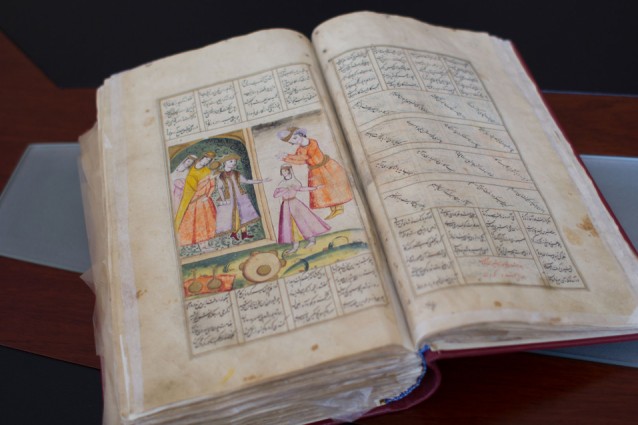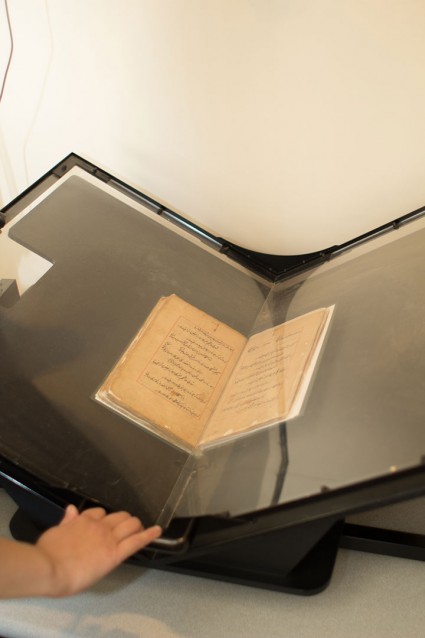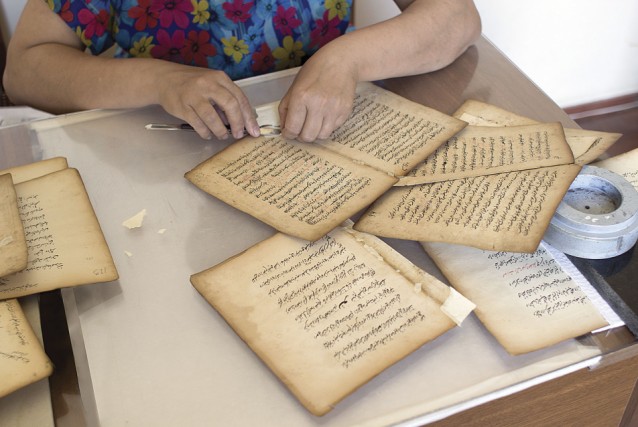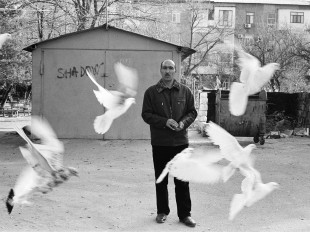Walking around the centre of Baku, one feels that every street and every building contains an entrancing spirit of the past. Not far from the Nizami Museum of Literature is a building which thousands of people pass everyday, but which many couldn’t even begin to guess what it is, nor what historical value it stores.
Like many buildings in central Baku, the one belonging to the Muhammad Fizuli Institute of Manuscripts has changed its function many times. Originally built by Haji Zeynalabdin Taghiyev in 1901 as a school for girls, it housed the parliament of the Azerbaijan Democratic Republic (ADR) in 1918-20 and later became a teacher-training centre and even the Supreme Soviet of the Azerbaijan SSR in the Soviet years. It wasn’t until 1982 that it was given to the Institute of Manuscripts, which was known as the Republican Manuscript Fund until 1986. The main purpose of this Institute, which operates under the Azerbaijan Academy of Sciences, is the collecting and cataloguing of old books and manuscripts of historical and scientific value for Azerbaijan, the Caucasus and the Muslim East.
Visions was given a recent tour, during which we learnt about the challenges of the restoration process: Many manuscripts were acquired by the Institute in the post-Soviet years and were often in a terrible state, having been hidden away from the Soviet authorities in cupboards and cellars for many years. Today, since many of them are written in Arabic script (Azerbaijani language was written using the Arabic script until 1929), they first have to be deciphered by a team of linguists and only then can be pieced back together with the painstaking precision of restoration specialists in the Institute’s laboratory. Downstairs in the Reading Room students and researchers are free to order and study from the Institute’s archive while upstairs visitors can browse the small museum in the hall where the parliament of the ADR once sat.
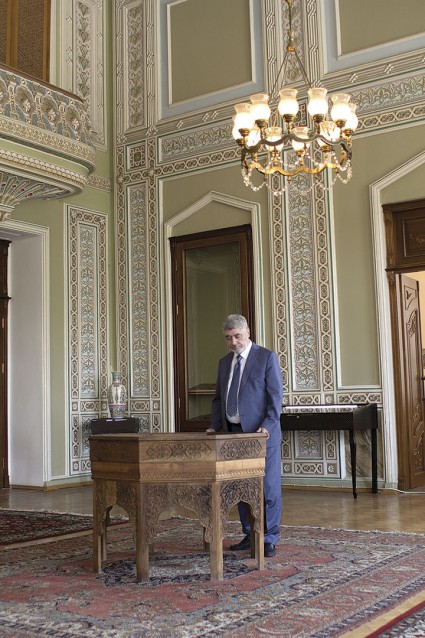 Director of the Institute of Manuscripts Mr Teymur Kerimli in the exposition hall, which is open to visitors six days a week. Photo: Tom Marsden
Director of the Institute of Manuscripts Mr Teymur Kerimli in the exposition hall, which is open to visitors six days a week. Photo: Tom Marsden
To learn more about this intriguing institution in the heart of Baku, we spoke to the Institute’s director, academician Mr Teymur Kerimli:
VoA - How did you come to work at the Institute of Manuscripts, what was your specialism?
TK - My basic education is philology. The literal translation of the word “philologist” is “a person who loves words” and manuscripts consist of words. So a philologist also means a person who loves manuscripts. From this point of view there is nothing strange in my being recruited by the Institute of Manuscripts. Besides, from more than 12,000 manuscripts in the Institute the majority are written in the Arabic alphabet and I know this alphabet very well. In other words, I also study the texts; I am a researcher of the manuscript texts.
What are the most interesting achievements the Institute has made?
The Institute’s most significant achievement is three Azerbaijani manuscripts on medieval medical and pharmaceutical history: Abulgasim Zahravi’s Al-Maqalatus-selasun (12th century), Abu Ali ibn Sina’s Al-Ganun fit-tibb (1143) and Rustam Jurjani’s Zakhirei-Nizamshahi (12th century), which were all included into the UNESCO World Memory Registry list on 29 July 2005.
In the period of independence, the Institute of Manuscripts has seen significant achievements in preparing and publishing academic and critical texts on Azerbaijani-language historical works which are written in their original scripts: for example, Muhammad Fuzuli’s Divan by H.M. Aliyev, Fuzuli’s Leyli and Majnun by A. Babayeva, Joseph’s poem Mehri and Vafa by K. Sherifli, Alijan Govsi Tabrizi’s Divan by P. Karimov, and Khatai Tabrizi’s Yusif and Zuleykha by T. Akbarov have been published for the first time and distributed among specialists.
I can also mention progress in cataloguing the manuscripts, publishing the bibliographic information of archival materials and preparing digital versions of the manuscripts.
Who uses the Institute? Can members of the public use it and if so how?
Materials kept at the Institute of Manuscripts may be used by scholars from research and higher education institutions interested in and studying the manuscripts, history, language, literature, philosophy and other spheres of science and culture of Azerbaijan and other peoples of the Muslim East. There are also foreign specialists among our readers. Both citizens of our country and foreigners can subscribe to our library as readers by applying with a letter from the head of the scientific research or higher education institution where they work or study detailing the exact purpose of study.
Readers are provided with the original manuscript or a copy in PDF format if there is an electronic version of the manuscript. Some manuscripts can be photocopied by readers with the permission of the management of the Institute of Manuscripts. We also provide transliteration of already published manuscripts for readers’ convenience. Almost all of the rare and valuable manuscripts in our Institute have electronic versions.
Can tourists or members of the public have tours of the Institute?
Tourists and the public can visit the Institute. The Institute of Manuscripts has a rich exposition hall. There are excursions in Azerbaijani, Russian and English informing guests about the history of the building, the manuscripts preserved here and the Institute’s areas of scientific work.
Besides, bearing in mind that visitors are very interested in the work of the Institute’s Laboratory of Hygiene and Restoration of Manuscripts, tourists can also observe the restoration process.
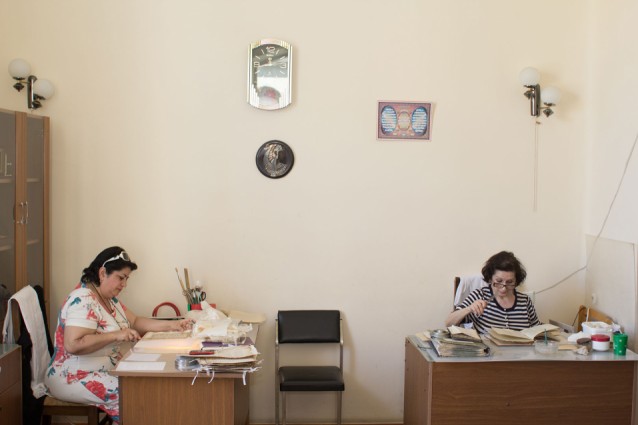 A team of expert restorers piece together old manuscripts. They aim to restore 1,000 pages per year. Photo: Tom Marsden
A team of expert restorers piece together old manuscripts. They aim to restore 1,000 pages per year. Photo: Tom Marsden
Have you had any famous international visitors?
Yes, for example: National Leader Heydar Aliyev; Amadou Mahtar M’Bow, former Secretary General of UNESCO; Abdulaziz Othman Altwaijri, Director General of the Islamic Educational, Scientific and Cultural Organization (ISESCO); Ali Akbar Hashemi Rafsanjani, former President of the Islamic Republic of Iran; Nazim Hikmat, world-renowned Turkish poet; our People’s Artists Muslim Magomayev, Tofiq Quliyev, Afrasiyab Badalbeyli, as well as well-known scientists and academicians such as Erich Feigl, Paul Taylor, Joseph Braginsky and many other respected intellectuals have visited the Institute of Manuscripts in different years.
Is the Institute cooperating with similar institutions abroad?
Since 2015, the Muhammad Fizuli Institute of Manuscripts has been a member of the International Islamic Manuscript Association at Cambridge University in the UK. We have worked closely with the King Abdul Aziz Foundation for Research and Archives in Saudi Arabia, the National Library of Morocco and the Arab League Institute of Arab Manuscripts. These establishments have very rich manuscript collections and libraries.
Besides collecting and preserving manuscripts, what are the other key areas of the Institute’s work today?
To meet modern requirements, we are creating an electronic catalogue of the Institute’s manuscripts as well as an electronic library of its rare and valuable manuscripts. We are also teaching difficult subjects such as philology, history, textual studies, source studies, art criticism and the preservation and the restoration of archival materials, and we intend to establish training courses for young people in ancient professions such as ebru art, miniature art, calligraphy and woodcarving.
Have there been any interesting or amusing incidents at the Institute of Manuscripts during its history?
This happened in the early years when the Manuscripts Fund became an institute on the initiative of National Leader Heydar Aliyev. During the summer holidays all the Institute’s well-known scholars were on vacation. The director of the Institute, Professor Jahangir Gahramanov was on holiday as well. Traditionally, one of the Institute’s scientists replaced him during this period.
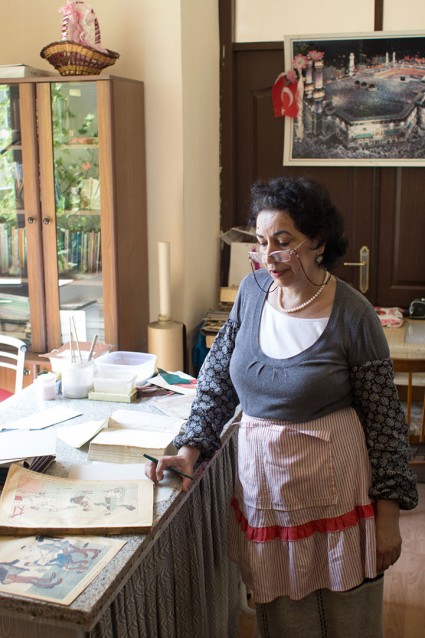 Firuza Pashayeva, who studied languages at university, has since been restoring manuscript covers at the Institute for many years. Photo: Tom Marsden
Firuza Pashayeva, who studied languages at university, has since been restoring manuscript covers at the Institute for many years. Photo: Tom Marsden
During this time, a journalist from a foreign country came to the Institute. He met with the scientist who was acting director at that time and said that he wanted to write an article about the famous manuscript specialists working at the Institute of Manuscripts. And the temporary acting director said that at present there weren’t any famous manuscript specialists at the Institute of Manuscripts except for him; if the journalist wanted to write something, he should write only about him. And the journalist did, he wrote a very good article about the scientific achievements and personal merits of that scholar.
Some time passed, and everyone returned to work from holiday. The director of the Institute also returned to work after the summer holidays in a good mood. A parcel came to the Institute on which was written: To the director of the Institute of Manuscripts. The director, professor Jahangir Gahramanov, opened the parcel. There was a magazine with articles about well-known scientists, including an article entitled: The Only Manuscript Specialist of the Institute of Manuscripts –– ... When the director saw the name expressed here by these dots, he got very angry and called the owner of the name. What is this? Do you mean that there aren’t any scientists at the Institute that can read manuscripts? he said. The person understood what had happened and said: What could I do? There weren’t any other scholars at the Institute when this article was written and I was the only scientist studying the manuscripts.
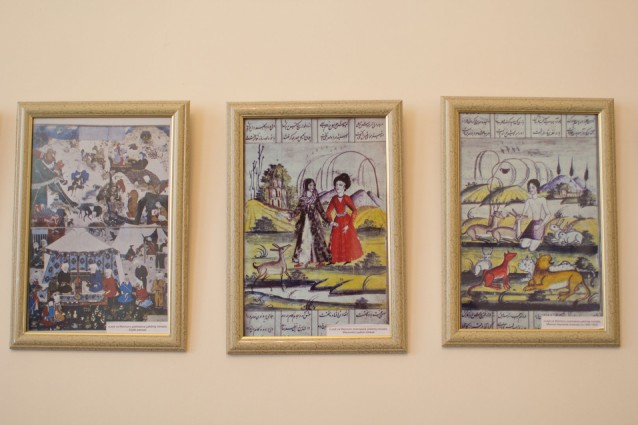 Miniatures from the poem Leyli and Mejnun by renowned 12th-century poet Nizami Ganjavi. Photo: Tom Marsden
Miniatures from the poem Leyli and Mejnun by renowned 12th-century poet Nizami Ganjavi. Photo: Tom Marsden
Famously, there is a debate about the author of the classic Azerbaijani novel Ali and Nino. Does the Institute have the original manuscript? Can you say conclusively who the original author was?
There isn’t a manuscript of this novel in the treasury of our Institute and we don’t share the opinion that it was written by the famous Azerbaijani writer Yusif Vazir Chamanzaminli. Yusif Vazir is quite a well-known writer and he had a peculiar style. Although we haven’t conducted any special research in this area, we think that this work belongs to Lev Nussimbaum, who signed his works as “Kurban Said.”
|
The Muhammad Fizuli Institute of Manuscripts Istiglaliyyat ave., 8, Baku Opening hours: Mon-Sat 10am – 4pm (994-12) 492–31–97 www.elyazmalarinstitutu.com |
